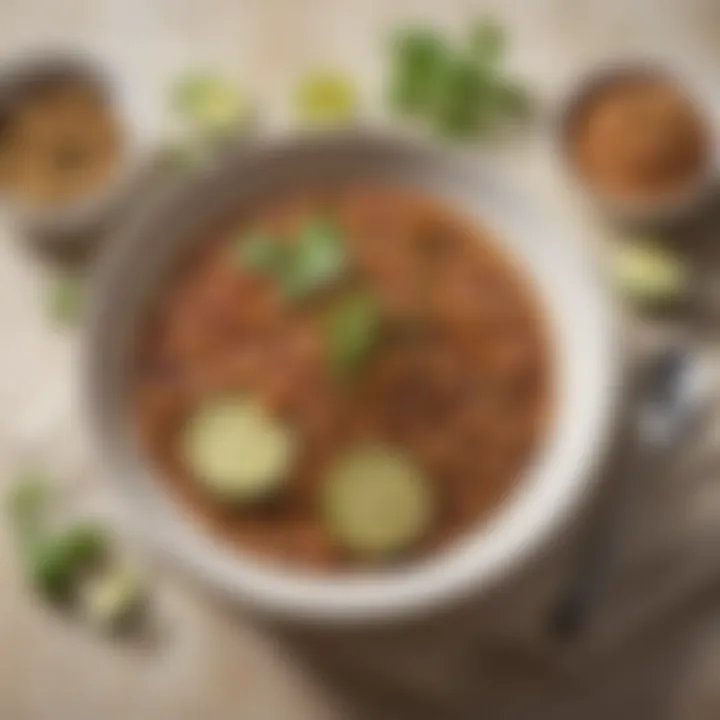Exploring the Flavorful Union of Beans and Lime


Intro
Beans and lime, though seemingly simple, bring an extraordinary depth to many dishes. Each ingredient offers a wealth of flavor, nutrition, and cultural significance, making them the unsung heroes of culinary traditions around the globe. Exploring their fusion not only reveals contrasting textures and tastes but also a shared history that reflects human resilience and ingenuity in the kitchen.
Throughout time, beans have been cultivated as a staple source of protein, while limes contribute a zesty tang that elevates everyday meals. Understanding the synergy between these two ingredients can lead to vibrant and nutritious meals that resonate with flavors celebrated by different cultures. This article will unfold the storied pasts of beans and lime, showcase nourishing recipes, and illuminate their versatility in cuisines from the Americas to Asia.
Get ready to dive into a world where humble pulses meet the bright notes of citrus, creating opportunities for novel culinary adventures and inviting culinary enthusiasts of all skill levels to explore the art of combining beans and lime.
Recipe Overview
Spicy Black Bean and Lime Tacos
These tacos encapsulate the robust flavors of seasoned black beans paired with a refreshing lime kick, wrapped in a soft tortilla. They represent a perfect balance of spice and zest, tailored for any meal of the day. Perfect for a quick lunch or an impulse dinner, they are both wholesome and satisfying.
Ingredients List
- Main ingredients
- Optional ingredients
- 1 can of black beans, drained and rinsed
- Juice of 2 limes
- 2 cloves of garlic, minced
- 1 teaspoon of chili powder
- Salt and black pepper to taste
- Small corn or flour tortillas
- Chopped cilantro for garnish
- Diced tomatoes or pico de gallo
- Avocado slices
- Sour cream or Greek yogurt
"The combination of beans and lime is an orchestra of flavors, each ingredient playing its part to create a symphony for the tastebuds."
This dish is a celebration of the rich textures and flavors that define bean and lime pairings. With its cultural ties to Mexican cuisine, the taco transforms into an inviting canvas for a variety of fresh toppings, making it a customizable favorite that anyone can enjoy. It’s a delicious example of how beans and lime can harmonize beautifully in any culinary setting.
Prelude to Beans and Lime
Beans and lime create a unique gastronomic partnership, enriching cuisines across the globe that draws in flavor enthusiasts and everyday cooks alike. Their charm lies not merely in their tastes but in their nutritional benefits and cultural weight. Beans pack a punch with their protein, while lime adds a refreshing twist that can transform an ordinary dish into something extraordinary.
This introduction serves to outline not just the core ingredients, but also their historical context and cultural significance. Knowing such factors enhances one’s appreciation for how these two ingredients complement each other and provide endless possibilities for creating memorable meals.
Defining the Core Ingredients
At first glance, beans may appear unassuming, yet they boast an impressive diversity. From kidney to black beans, their textures and flavors vary, making them versatile allies in culinary applications. They serve as a base for hearty dishes, adding substance and a comfort food vibe. Lime, on the other hand, with its sharp acidity, offers a zesty counterbalance. It enhances flavors, brightens heavy meals, and brings a mouthwatering twist to the table.
Historical Context and Cultural Significance
Origins of Beans
Beans have a long . . . that dates back thousands of years. Archaeological evidence suggests that they were cultivated in regions of Central and South America as far back as 7,000 years ago. Not only did they provide essential nutrients, but they also became a staple food in various cultures.
What sets beans apart is their adaptability to different environments, allowing them to flourish in diverse climates and soil types. This has let them anchor numerous dishes in many cultures. They contribute to comforting home meals and are often associated with communal gatherings, giving them a special place on the dining table.
They are not just sustenance; they symbolize community and resilience. This depth of history adds a layer of meaning to their use with lime.
Origins of Lime
Similarly, lime's journey traces back to Southeast Asia, where its refreshing zest first captivated many. Explore any traditional dish from the tropics, and lime is likely to make an appearance. Its pungent acidity has dictated how dishes evolve in various cuisines, elevating flavors drastically.
Lime is not just a garnish; its juice and zest can give dishes vibrancy and life. This aspect makes it an invaluable ingredient in both light and heavy dishes, blending effortlessly from salsas to marinades. Its presence is a refreshing reminder of the sun and warmth, balancing the heartiness of beans beautifully.
Regional Variations in Usage
The interplay between beans and lime varies by region, showcasing a tapestry of flavors and combinations that break barriers. In Mexican cuisine, one may find black beans topped with a splash of lime juice, a match made in culinary heaven. In contrast, in Thai cooking, lime plays up the depth of beans in curries or salads, revealing the flexibility of these ingredients.
Regional dishes may often reflect local ingredients and methods, illuminating communities' characteristics. The diversity in bean and lime dishes illustrates their adaptability, showing how they can be interpreted and valued across cultures. Guests from different culinary backgrounds can bond over how the simplest combinations can create stunning experiences.
This connection between histories and dishes highlights the timelessness of these ingredients, making every meal a celebration of shared stories and flavors.
Exploring beans and lime offers a glimpse into human creativity in the kitchen, giving rise to dishes that are rich, wholesome, and above all, delicious.
Nutritional Insights
Understanding the nutritional insights of beans and lime provides a solid foundation for appreciating their roles in our diets. Beans, revered for their high protein content and fiber, make them fantastically versatile from salads to stews. Lime, with its zesty tang, doesn’t just enhance flavors but also packs a punch of nutrients, particularly vitamin C. When combined, these ingredients not only boost the taste but also amplify the health benefits in your meals, making them essential in any health-conscious kitchen.


Nutritional Profile of Beans
Proteins and Fibers
Beans are renowned for their nutritional prowess, especially their impressive amounts of proteins and dietary fibers. These legumes are often considered a staple for vegetarian diets due to their protein content, which can rival that of meat. Each serving contains between 15 to 30 grams of protein, depending on the type. Additionally, their fiber content helps regulate digestion, keeps you feeling full longer, and can stabilize blood sugar levels.
One of the standout features of beans is the soluble fiber they provide. This kind of fiber blends with water to form a gel-like substance in the intestines. This property not only aids in digestion but also lowers cholesterol levels, thus promoting heart health. While they are generally a healthy choice, it’s important to note that for some, beans can cause gastrointestinal discomfort if not cooked properly. Therefore, soaking and cooking them correctly is crucial.
Vitamins and Minerals
Beans aren’t just about fiber and protein; they also harbor a treasure trove of vitamins and minerals. Rich in folate, iron, magnesium, and potassium, beans play a critical role in maintaining optimal health. For instance, folate is essential for cell division and the production of DNA, while iron is vital for energy levels and oxygen transport in the blood.
A unique aspect of beans is their bioavailability of minerals, which means that the nutrients are easily absorbed by the body, especially when paired with vitamin C-rich foods like lime. While beans do provide numerous health benefits, individuals with specific mineral deficiencies should ensure they combine them with various ingredients to maximize absorption.
Health Benefits of Lime
Citrus and Immune Function
Lime is often celebrated for its bright flavor and refreshing qualities, but it also boasts substantial health benefits. A key characteristic of lime is its high vitamin C content, which plays a pivotal role in boosting the immune system. This vitamin is an antioxidant, protecting cells from damage and supporting various bodily functions.
Additionally, the citric acid in lime can enhance the absorption of minerals like iron, making it an ideal partner for beans, with their aforementioned iron content. For many, incorporating lime into their daily diet can serve as a very simple yet effective way to fortify immune response.
Antioxidant Properties
Another fascinating aspect of limes is their potent antioxidant properties. Antioxidants work to mitigate oxidative stress, thereby reducing the risk of chronic diseases such as heart disease and cancer. Lime, with its rich antioxidant compounds, including flavonoids and polyphenols, acts not just as a flavor enhancer but as a valuable health ally.
While the health benefits of lime are numerous, it is worth noting that excessive acidity may lead to dental erosion or tooth sensitivity over time. Therefore, moderation is key, particularly for those who might be more susceptible to dental issues.
Combined Nutritional Benefits
Synergistic Effects on Health
When beans and lime are combined, their health benefits work in tandem to create a synergistic effect. This means that the whole is greater than the sum of its parts; the nutrients in both ingredients complement and enhance each other's absorption and efficacy. For example, the iron-rich beans can be better utilized by the body when combined with vitamin C from lime, making meals not only more flavorful but nutritionally sound.
These synergistic effects can lead to better overall digestion and nutrient absorption, helping individuals maintain optimal health, provided they are mindful of meal preparation methods.
Meal Planning with Beans and Lime
Planning meals that incorporate both beans and lime can be a delightful and nutritious experience. Their versatility makes them suitable for breakfast, lunch, dinner, or even snacks. For breakfast, consider a lime-infused bean spread on whole-grain toast. For lunch, toss them into a salad with a zesty lime dressing. And dinner could feature a refreshing lime sauce on a warm bean stew.
By being intentional in meal planning, one can optimize not only flavor but also the nutritional profile of their diet. This thoughtful approach can yield benefits in both culinary delight and health enhancement.
Culinary Techniques with Beans and Lime
The exploration of beans and lime in cooking goes far beyond simply tossing these ingredients together. Understanding the culinary techniques involved in their preparation and incorporation can truly elevate your dishes. Both beans and lime possess distinct properties that not only enhance flavors but also contribute significant nutritional benefits when properly utilized. The aim here is to investigate methods that bring out the best qualities of these ingredients, ensuring that your culinary creations are both delightful and wholesome.
Preparing Beans: Methods and Tips
Soaking and Cooking
Soaking beans before cooking is like giving them a warm welcome into the culinary world. This fundamental step softens the beans, reducing cooking time significantly, and it also helps in breaking down some of the indigestible sugars that often lead to discomfort. By soaking beans overnight or for at least a few hours, you’ll find them yielding a creamier texture once cooked. This characteristic stands out especially in dishes such as refried beans or any bean-based dips, where smoothness can make or break the dish.
One unique feature of soaking is that it allows for better absorption of flavors during cooking. Think of it as priming your beans for the flavor bomb they are about to encounter. On the downside, the need for foresight can be a hassle for cooks who decide to whip up a meal last minute. With that in mind, timing is essential.
Using Canned vs. Dried
Both canned and dried beans come with their own sets of pros and cons. Canned beans are a lifesaver for quick meals; they are pre-cooked and ready to go, reducing the hassle in the kitchen. You pop the can open, drain, and voilà! Instant beans for stews or salads. It’s a practical choice for those who find themselves strapped for time, making it a popular pick in many households.
On the other hand, using dried beans can provide an unparalleled depth of flavor that often gets lost in the canning process. Dried beans allow for complete control over seasoning during cooking. However, this necessitates planning and potentially a few extra hours, which may not be ideal for everyone. The challenge lies in weighing convenience against flavor profiles.
Incorporating Lime into Dishes
Juicing and Zesting
Incorporating lime into your meals can be as simple as juicing a fresh fruit or zesting its skin for added flavor. Juicing is a great way to release the vibrant, tangy juice that can balance out the richness of beans seamlessly. A splash of lime juice can brighten any dish, bringing a lively burst of freshness that cuts through heaviness and enhances the overall taste profile.
Zesting, on the other hand, introduces a different dimension. The outer skin of the lime is packed with essential oils, which add a fragrant note that can uplift a dish without overpowering it. However, while juicing provides acidity, zesting gives a more nuanced flavor without additional liquid. This technical differentiation is key for precision-minded cooks.


Using Lime as a Marinade
Lime serves not just as a flavor enhancer; its acidic properties make it an excellent marinade component. When used as a marinade, lime helps to tenderize proteins while infusing them with a citrusy zing. This method works particularly well with meats, but it can also add a marvelous depth to bean-based dishes.
A marinade exploits lime's unique qualities to create a subtle crust on the protein as it cooks, leading to a range of textures and flavors that keep a dish interesting. Yet, one must be cautious; too much lime or prolonged exposure can overpower other flavors or even make the dish unbearably sour.
"Using lime in your cooking not only enhances flavors but also introduces a level of creativity to your culinary practices."
As such, understanding these culinary techniques allows food enthusiasts to maximize the potential of beans and lime, ensuring that their meals are not just sustenance but also a delight for the senses. From soaking dried beans to crafting a zesty marinade, each technique tells a story that resonates with flavors and cultural traditions.
Recipe Exploration Featuring Beans and Lime
Exploring recipes that incorporate beans and lime can reveal unique flavor profiles and textures that delight the palate. Such recipes not only celebrate the dynamic duo of ingredients, but also embody cultural narratives from various traditions around the globe. In this section, we will look into classic combinations and international inspirations, emphasizing how these culinary options not only nourish the body but also ignite creativity in the kitchen.
Classic Bean and Lime Combinations
Bean Salads with Lime Dressing
A refreshing bean salad dressed in lime can truly be a star on any table. This recipe highlights the vibrant notes of lime, cutting through the richness of beans. Whether using black, kidney, or chickpeas, the salad's composition benefits from the zesty dressing made from fresh lime juice, oil, and a pinch of salt. The balance between acidity and creaminess makes it a popular choice among those aiming for something light yet filling.
The unique feature of a bean salad with lime dressing is its versatility. You can toss in vegetables like bell peppers, onions, or corn to create a colorful medley. With its ease of preparation, this dish can be made in a jiffy, perfect for weeknight dinners or picnics.
On the downside, lime-dressed salads can be a bit too citrusy for some who may prefer milder flavors. This could limit its widespread appeal, but for those who enjoy a kick of zest, it's simply a winner.
Bean Tacos with Lime Crema
Moving on to something even more enticing, bean tacos served with lime crema can take your taco night up a notch. The creaminess of the lime-infused crema balances perfectly with the seasoned beans, making every bite a delightful experience. Use refried beans or whole beans, topped with a blend of lime juice and sour cream or Greek yogurt to craft a topping that dances on the taste buds.
The key characteristic of these tacos is their balance of flavors. The richness of the beans melds with the tangy crema, and each taco can be customized with additions like avocado, salsa, or fresh cilantro. This flexibility makes bean tacos an excellent option for feeding a crowd or providing a satisfying meal for one.
However, depending on the amount of lime used in the crema, it can lean toward being overly sour, potentially overshadowing other toppings. But, for many, this is the sweet spot that provides contrast without overpowering the dish—it's all about balance!
International Inspirations
Mexican Refried Beans with Lime
Mexican cuisine famously celebrates beans in numerous roles, and refried beans with a hint of lime stand out as a comfort dish. This preparation really enhances the creamy texture of the beans, providing a soothing dish that pairs well with rice, tortillas, or even plantains. The introduction of lime not only adds a zesty brightness but also helps in balancing the dish's creaminess.
The benefit of including lime here is the added freshness it provides, which can often be missing in heavier fare. The invigorating punch of citrus makes every mouthful enjoyable. While this dish is generally loved, too much lime can overpower the soft, comforting nature of the beans, leading to an imbalanced flavor. Thus, a light squeeze is often the way to go.
Peruvian Bean Stews with Citrus
In Peru, bean stews that incorporate citrus lend a unique twist to a traditional dish. These stews often simmer for hours, allowing the beans to absorb strong flavors from various herbs and vegetables. Adding lime towards the end of cooking brightens the dish significantly.
The charm of Peruvian bean stews with citrus lies in their depth and warmth. They often showcase local spices, presenting an exotic blend that captures the essence of Peruvian heritage.
One advantage here is that the stews are comforting and filling, making them perfect for family meals. A possible drawback is the long cooking time, which might deter those looking for quick options. Yet, the reward of deep flavors makes the wait worthwhile for an enriching culinary experience.
"Beans and lime are not just ingredients; they're vessels of cultural stories, inviting us on a journey through flavor and tradition."
Overall, these recipes demonstrate the potential of beans and lime to create unforgettable experiences in the kitchen, utilizing diverse culinary practices and preferences for vibrant meals.
Cultural Perspectives on Beans and Lime
Exploring the cultural aspects surrounding beans and lime unveils a rich tapestry of culinary traditions. These ingredients serve as cornerstones in various cuisines, particularly in Latin America and parts of Asia, highlighting their adaptability and significance. Their historical involvement in local diets not only enriches flavors but also influences regional identities and social practices. Both beans and lime are not just ingredients; they are symbols of cultural intertwining, fusing various culinary practices and bringing communities together across generations.
Beans and Lime in Latin American Cuisine
Regional Variations
Latin America is a continent of immense diversity, and the way beans and lime are utilized greatly varies from one region to another. For instance, in Mexico, black beans are predominantly used, whereas in Brazil, the focus shifts to pinto beans. The integration of lime also transforms dishes distinctly. The fresh zestiness of lime is often paired with beans in hearty meals and street foods, tying together flavors in ways that are distinctly regional.
Such regional differences provide each dish with a unique character while showcasing local agricultural practices. The variation in beans and the type of limes used - whether it’s Persian lime or key lime - impacts the nutrient profiles and flavor, making it a wise choice to include them in dishes. These unique characteristics foster culinary innovation while honoring tradition. However, the challenge remains in maintaining authenticity in a rapidly globalizing world.
Role in Traditional Dishes
Beans and lime play an indispensable role in traditional Latin American dishes. For example, the classic dish of ceviche utilizes lime not just for flavor but also as a natural preservative, while beans often form the base of a traditional all-day breakfast in many cultures. The presence of these ingredients helps to create not only a nutritious meal but also a social gathering space where families and friends connect over food.


This symbiotic relationship between beans and lime signifies its cultural importance, representing sustenance and community. However, it’s essential to remember that while these dishes hold cultural value, access to high-quality ingredients can present challenges, particularly in urban areas with limited access to fresh produce.
Incorporation in Asian Cuisines
Indonesian Bean Dishes
In Indonesia, beans are far from being mere side players; they are central to many traditional dishes. The use of tempeh, a fermented soybean product, has garnered worldwide acclaim for its health benefits. Indonesian bean dishes often mingle with rich spices and fruity components, including lime, creating a nuanced flavor profile that speaks to the country’s culinary heritage. Many recipes, such as tempeh stir-fry, utilize lime zest to enhance the umami of beans, crafting a delightful culinary experience.
This blend of flavors illustrates not only the health benefits of legumes but also their versatility in various cooking methods. Yet, global appreciation can sometimes overshadow local traditions, complicating how such dishes are presented on the global stage.
Thai Flavors with Lime
Shifting over to Thai cuisine, lime takes the front seat, amplifying the fresh, aromatic qualities of bean-based dishes. In a hot Thai salad called "Som Tam," for instance, green beans are mixed with fresh herbs, chilies, and lime juice, creating a delightfully vibrant dish that thrives on balance. The sourness from lime elevates the flavor, bringing out the natural sweetness of the beans.
This interaction of flavors not only caters to culinary preferences but also embodies the Thai philosophy of harmonizing taste in meals, spotlighting the refreshing attributes of lime and the heartiness of beans. While these combinations are gastronomically satisfying, they also represent how culinary practices can evolve while keeping roots firmly planted in tradition.
Sustainability and Ethical Considerations
The intertwining of sustainability and culinary practices becomes increasingly vital in today’s world. As food lovers, diving into the diverse realm of beans and lime also beckons us to consider the environmental impact of these ingredients as well as the ethics surrounding their production.
Environmental Impact of Bean Production
Carbon Footprint of Legumes
Beans hold a unique position in agriculture due to their low carbon footprint compared to many other protein sources. The cultivation of legumes, like beans, contributes positively to soil health by fixing nitrogen, a vital nutrient that plants need to flourish. This phenomenon means that they typically require less synthetic fertilizer, which reduces greenhouse gas emissions associated with farming. In other words, incorporating beans in our diets isn't just delicious, it also supports a more sustainable agricultural approach.
One noteworthy characteristic of beans is their ability to grow in diverse conditions. Many varieties exhibit resilience to microorganisms and pests. This not only reduces the necessity for pesticides, which often have detrimental environmental impacts, but also promotes biodiversity. Therefore, choosing beans means choosing an ingredients that roots down deeply in sustainability discussions.
Water Usage in Agriculture
Water play a pivotal role in agriculture, and beans relatively have lower water requirements in comparison to other crops such as rice or certain vegetables. Growing beans typically demands 30% less water, which is particularly beneficial in water-scarce regions. This efficient usage can alleviate pressure on local water sources, essentially providing a more eco-friendly approach to both farming and eating.
Additionally, bean farming utilizes various farming systems, some of which thrive on rain-fed irrigation rather than extensive irrigation systems. This aspect not only conserves water but also fosters sustainable practices. However, it's important to source these beans mindfully, ensuring they come from regions committed to sustainable practices.
Sourcing Ethical Lime Products
Fair Trade Practices
Ethical sourcing plays an essential role in ensuring a better livelihood for producers, especially for commodities like lime, primarily grown in tropical regions. Fair Trade practices aim to provide fair prices, decent working conditions, and sustainable farming practices to the workers. This balances the needs of people and the environment.
The principle of paying fair prices can help lift communities out of poverty. By supporting fair trade limes, you contribute to a system that cherishes social equality and environmental responsibility. It also means knowing where your food comes from, building a connection between consumers and producers.
Local vs. Imported Produce
This topic raises important questions about sustainability in our culinary choices. Choosing local lime versus imported ones has implications for freshness, environmental impact, and community support. Local produce usually means lower transportation emissions. Moreover, when you buy locally, you help support local farmers, strengthening community ties.
On the flip side, imported limes can sometimes offer greater availability and variety, but they can also carry a higher carbon footprint due to shipping logistics. Being informed about sourcing practices allows consumers to make better choices aligned with their values and priorities.
In this grand culinary exploration of beans and lime, it’s essential not just to savor their flavors but also to consider our role in shaping a more sustainable food system. Each choice matters, and through mindful consumption, we can contribute to a healthier planet and healthier communities.
Closure: The Endless Possibilities with Beans and Lime
Beans and lime bring an impressive array of flavors and benefits to the table, underscoring the versatility of these ingredients in the culinary landscape. Their pairing is not merely a coincidence; the natural harmony between the earthiness of beans and the bright acidity of lime enhances many dishes, leaving a lasting impression on the palate.
An essential part of this exploration is acknowledging how beans and lime not only create delicious meals but also elevate nutritional health. Beans are a powerhouse of protein, fiber, and various vitamins, while lime contributes essential minerals and antioxidants. Together, they provide a balanced meal that satisfies hunger without compromising wellness. Cooking with these ingredients reinforces mindful eating, which has recently garnered more attention in our health-conscious society.
Beyond their health benefits, the notion of experimenting in the kitchen with beans and lime is one that encourages creativity. They can be incorporated into traditional dishes or twisted into new, innovative recipes. Whether one is a seasoned chef or a novice in the kitchen, the flavors of beans and lime offer a vast canvas for culinary expression.
Encouraging Experimentation in the Kitchen
One of the most exciting aspects of using beans and lime is the potential for experimentation. The kitchen should be a playground where flavors can collide and transform typical meals into extraordinary experiences. For instance, consider using lime zest in prosciutto-wrapped beans for a refreshing appetizer. Adding lime while sautéing black beans creates a new depth that can redefine a classic stir-fry.
Here are a few suggestions to spark creativity:
- Experiment with various bean types: Try black beans, chickpeas, or cannellini in combination with lime. Each type brings its unique characteristics.
- Add herbs: Fresh cilantro, mint, or basil can complement beans and lime, enhancing the flavor profile.
- Play with textures: Consider a creamy black bean dip topped with a citrus-lime drizzle or a refreshing bean salad that incorporates crunchy veggies.
- Twist on classics: Transform a standard bean chili by adding lime juice for an unexpected zing.
As they say, variety is the spice of life. By thinking outside the box, the ordinary can be made extraordinary, and the possibilities truly become endless.
Final Thoughts on Flavor and Wellness
Reflecting on our journey through the world of beans and lime prompts one to recognize their remarkable role in the kitchen beyond mere sustenance. These two ingredients not only tantalize taste buds but also promote health and wellbeing. The simple act of adding lime juice can uplift flavors, turning a mundane dish into something memorable.
Encouraging a deeper appreciation for beans and lime fits hand in hand with the contemporary emphasis on sustainability and wellness. Sourcing these ingredients locally not only supports the community but also enriches the culinary experience.







